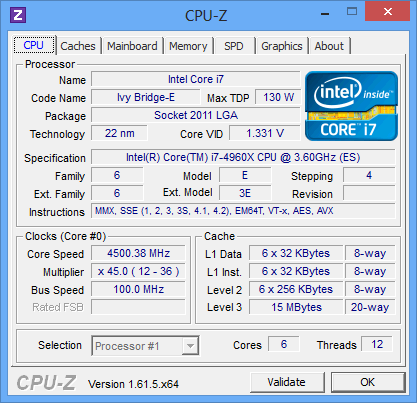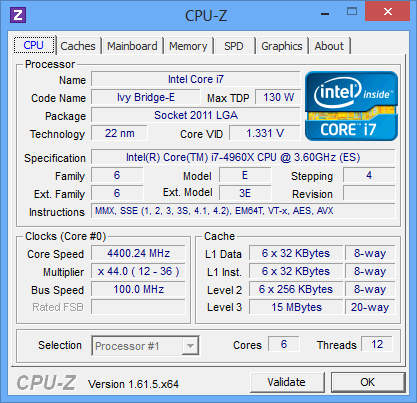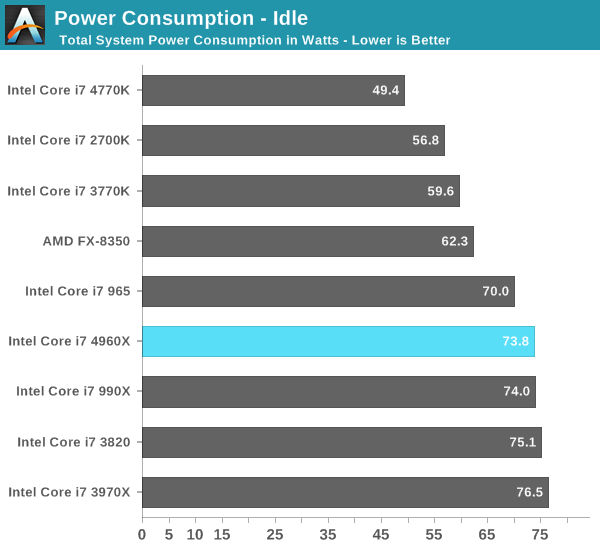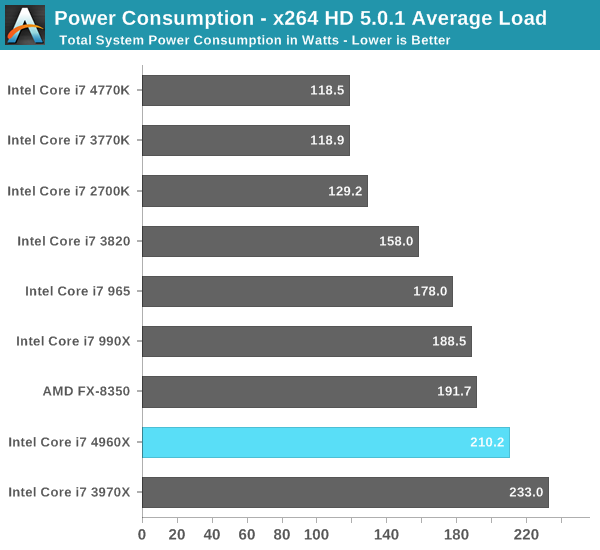Intel Core i7 4960X (Ivy Bridge E) Review
by Anand Lal Shimpi on September 3, 2013 4:10 AM EST- Posted in
- CPUs
- Intel
- Ivy Bridge
- Ivy Bridge-E
Overclocking
As I mentioned earlier, all of the IVB-E launch SKUs ship fully unlocked. Intel offers multipliers up to 63x for you to choose from when overclocking. Like SNB-E before it, IVB-E supports specific BCLK straps (125MHz and 166MHz, in addition to 100MHz) for those overclockers looking to get the absolute most out of their chip. At these overclocked BCLK frequencies, PCIe and other buses are properly divided down so they aren't overclocked (although if you increase the BCLK frequency beyond these strap defaults you will once again be overclocking other buses that derive their frequencies from BCLK). In practice, the cleanest/simplest way to overclock any K-series SKU is by increasing the multiplier.

In our review of the Core i7-3960X I managed a maximum stable overclock of 4.6GHz. I've been told to expect a similar average for Ivy Bridge E. Using Intel's RTS2011LC self contained/closed loop liquid cooling solution I could get into Windows 8 as high as 4.6GHz at 1.42V, however my testbed wasn't stable through all of my tests at that frequency/voltage combination. Moving to higher voltages didn't help, so I had to back down on frequency. I ultimately ended up perfectly stable at 4.3GHz, with 4.4 - 4.5GHz possible with better cooling. The added power needed to hit these frequencies was substantial. I measured a 58W increase in average load power consumption at 4.3GHz/1.4V.

From what I've seen, my sample is a bit on the disappointing side in terms of overclockability. Either way, it doesn't look like you're going to be seeing overclocks significantly higher than what was possible with SNB-E.
Power Consumption
With the 4960X delivering around 5% better performance than the 3970X, the only remaining question is how much more power efficient the move to 22nm made things. Using the same ASUS X79 Deluxe board for both parts, I was able to answer that question.
At idle there's hardly any difference between SNB-E and IVB-E. Under load it looks like IVB-E is good for around a 20W reduction in total system power. It's not an insignificant savings, but definitely not enough to warrant an upgrade if you're on SNB-E already. Anyone looking to migrate to LGA-2011 for the first time will want to go with IVB-E as it is the more thermally efficient solution.












120 Comments
View All Comments
Snoopykins - Tuesday, September 3, 2013 - link
Excellent review. I must say the reviews Anand himself writes always seem to be spot on. One question, where does the 22 months number come from? Is that the scheduled/rumored/leaked release date of Haswell-E? If so, isn't that going to be even more behind than Ivy-E? I'm assuming Skylake will have been out for longer than Haswell has been out now, no? Also, do we know that Skylake will support DDR4? I've heard Haswell-E will.Anywho, thanks for the excellent review, I thoroughly enjoyed it.
eiriklf - Tuesday, September 3, 2013 - link
22 months is about the time between the releases of sandy bridge extreme and ivy bridge extreme1Angelreloaded - Tuesday, September 3, 2013 - link
Haswell-e will if they move to a new socket and board DDR4 probably won't be compatible with DDR3 DIMM sockets.hrrmph - Tuesday, September 3, 2013 - link
Yep, that was a great review.It's not often that I think that a review really nails it all (at least for what I need), but this one did it. Very balanced, taking shots at the weak points, while also thoroughly explaining what is good about it, and who it might benefit.
X79 is adequate only if you are willing to load your machine up with lots of add-in controller cards.
Intel will really need to up their game on the chipset when Haswell-E gets here.
jasonelmore - Tuesday, September 3, 2013 - link
most modern x79 boards have all the add on controllers soldered onto the motherboard. Cards are not needed.just4U - Friday, September 6, 2013 - link
With so few new things coming out in the desktop division these days Im sure Anand is quite fine to getting back into the trenches to do the odd review. Used to be (or so it seemed) every other day we were getting glimpses at exciting new things but these days that appears in the form of tablets and smartphones /w the desktop industry being somewhat stagnant in my opinion.dishayu - Tuesday, September 3, 2013 - link
At this rate, as Anand suggests, Haswell-E will come out around/after Skylake based Desktop parts(assuming that is still on track for 2015 release). I am convinced that it would have been a better approach to skip Haswell-E altogether and jump straight to Skylake-E in 2015. This logic is further supported by the fact that next gen will require a new socket design (since Haswell comes with FIVR).jasonelmore - Tuesday, September 3, 2013 - link
there is still a node jump to go through. Most of the time this delays projected release dates. Broadwell may be late.Kevin G - Wednesday, September 4, 2013 - link
Since there is going to be a Haswell refresh in 2014, I'd expect Haswell-E to be introduced around the same time: roughly a year from now. The delay of Broadwell on the desktop will allow Haswell-E to catch up in cadence a bit.The new question is when Broadwell-E will arrive: with Skylake or vanilla Broadwell on the desktop?
f0d - Tuesday, September 3, 2013 - link
nice cpu for those that have an older platform (like 1156 or 1366 maybe) but as someone that already owns a 2011 socket cpu im still hoping they will eventually release 8 or even 10/12 core cpu's so i can encode vids fastercmon intel release those 8/10/12 core cpu's for the enthusiast platform.!